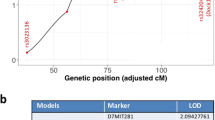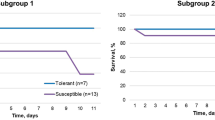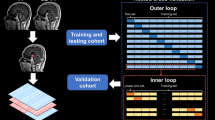Abstract
Rb+/− mice develop a complex spectrum of neuroendocrine tumors on a mixed genetic (129Sv × C57BL/6) background. To understand how the 129Sv and C57BL/6 contributions affect Rb+/− tumorigenesis, we serially backcrossed Rb+/− animals to the 129Sv or C57BL/6 strain, and analysed their pathological profiles. Strikingly, the length of survival and the penetrance, severity and multiplicity of neuroendocrine tumors switch dramatically between Rb+/− animals from the two genetic backgrounds. In fact, the 129Sv background significantly enhances both the initiation and progression of tumorigenesis in the intermediate lobe of the pituitary (ILP) in Rb+/− animals. This is due to the surprising fact that ILPs from wild-type 129Sv animals are inherently abnormal, and thus greatly predisposed to neoplasia. This is likely to explain the high incidence of ILP tumors, an otherwise rare tumor type in wild-type mice, in numerous knockout studies performed on the 129Sv strain, and raises the intriguing possibility that the classic Rb+/− neuroendocrine tumors may fade away in another as of yet unidentified inbred strain. Finally, we have increased the utility of the Rb+/− tumor model, since Rb+/− animals on the C57BL/6 background develop high-penetrance tumors of the anterior lobe of the pituitary, a class of tumors estimated to occur in 20–25% of humans.
This is a preview of subscription content, access via your institution
Access options
Subscribe to this journal
Receive 50 print issues and online access
$259.00 per year
only $5.18 per issue
Buy this article
- Purchase on SpringerLink
- Instant access to full article PDF
Prices may be subject to local taxes which are calculated during checkout






Similar content being viewed by others
References
Asa SL and Ezzat S . (2002). Nat. Rev. Cancer, 2, 836–849.
Bernards R, Schackleford GM, Gerber MR, Horowitz JM, Friend SH, Schartl M, Bogenmann E, Rapaport JM, McGee T, Dryja TP and Weinberg RA . (1989). Proc. Natl. Acad. Sci. USA, 86, 6474–6478.
Brugarolas J, Bronson RT and Jacks T . (1998). J. Cell Biol., 141, 503–514.
Cam H and Dynlacht BD . (2003). Cancer Cell, 3, 311–316.
Clarke AR, Maandag ER, van Roon M, van der Lugt NM, van der Valk M, Hooper ML, Berns A and te Riele H . (1992). Nature, 359, 328–330.
Classon M and Harlow E . (2002). Nat. Rev. Cancer, 2, 910–917.
Cloud JE, Rogers C, Reza TL, Ziebold U, Stone JR, Picard MH, Caron AM, Bronson RT and Lees JA . (2002). Mol. Cell. Biol., 22, 2663–2672.
Cobrinik D, Lee MH, Hannon G, Mulligan G, Bronson RT, Dyson N, Harlow E, Beach D, Weinberg RA and Jacks T . (1996). Genes Dev., 10, 1633–1644.
Cryns VL, Alexander JM, Klibanski A and Arnold A . (1993). J. Clin. Endocrinol. Metab., 77, 644–646.
Dannenberg JH, van Rossum A, Schuijff L and te Riele H . (2000). Genes Dev., 14, 3051–3064.
de Bruin A, Wu L, Saavedra HI, Wilson P, Yang Y, Rosol TJ, Weinstein M, Robinson ML and Leone G . (2003). Proc. Natl. Acad. Sci. USA, 100, 6546–6551.
de Vos S, Miller CW, Takeuchi S, Gombart AF, Cho SK and Koeffler HP . (1995). Genes Chromosomes Cancer, 14, 164–170.
Fero ML, Rivkin M, Tasch M, Porter P, Carow CE, Firpo E, Polyak K, Tsai LH, Broudy V, Perlmutter RM, Kaushansky K and Roberts JM . (1996). Cell, 85, 733–744.
Franklin DS, Godfrey VL, Lee H, Kovalev GI, Schoonhoven R, Chen-Kiang S, Su L and Xiong Y . (1998). Genes Dev., 12, 2899–2911.
Franklin DS, Godfrey VL, O'Brien DA, Deng C and Xiong Y . (2000). Mol. Cell. Biol., 20, 6147–6158.
Gary KA and Chronwall BM . (1992). Int. J. Dev. Neurosci., 10, 131–142.
Harbour JW, Lai SL, Whang-Peng J, Gazdar AF, Minna JD and Kaye FJ . (1988). Science, 241, 353–357.
Harrison DJ, Hooper ML, Armstrong JF and Clarke AR . (1995). Oncogene, 10, 1615–1620.
Hayashi N, Sugimoto Y, Tsuchiya E, Ogawa M and Nakamura Y . (1994). Biochem. Biophys. Res. Commun., 202, 1426–1430.
Hu N, Gutsmann A, Herbert DC, Bradley A, Lee WH and Lee EY . (1994). Oncogene, 9, 1021–1027.
Humbert PO, Verona R, Trimarchi JM, Rogers C, Dandapani S and Lees JA . (2000). Genes Dev., 14, 690–703.
Ishida S, Huang E, Zuzan H, Spang R, Leone G, West M and Nevins JR . (2001). Mol. Cell. Biol., 21, 4684–4699.
Jacks T, Fazeli A, Schmitt EM, Bronson RT, Goodell MA and Weinberg RA . (1992). Nature, 359, 295–300.
Kalma Y, Marash L, Lamed Y and Ginsberg D . (2001). Oncogene, 20, 1379–1387.
Kinzler KW and Vogelstein B . (1998). Science, 280, 1036–1037.
Kiyokawa H, Kineman RD, Manova-Todorova KO, Soares VC, Hoffman ES, Ono M, Khanam D, Hayday AC, Frohman LA and Koff A . (1996). Cell, 85, 721–732.
Knudson AG . (1997). Ann. NY Acad. Sci., 833, 58–67.
Kratzke RA, Greatens TM, Rubins JB, Maddaus MA, Niewoehner DE, Niehans GA and Geradts J . (1996). Cancer Res., 56, 3415–3420.
LeCouter JE, Kablar B, Hardy WR, Ying C, Megeney LA, May LL and Rudnicki MA . (1998a). Mol. Cell. Biol., 18, 7455–7465.
LeCouter JE, Kablar B, Whyte PF, Ying C and Rudnicki MA . (1998b). Development, 125, 4669–4679.
Lee EY, Cam H, Ziebold U, Rayman JB, Lees JA and Dynlacht BD . (2002). Cancer Cell, 2, 463–472.
Lee EY, Chang CY, Hu N, Wang YC, Lai CC, Herrup K, Lee WH and Bradley A . (1992). Nature, 359, 288–294.
Lee MH, Williams BO, Mulligan G, Mukai S, Bronson RT, Dyson N, Harlow E and Jacks T . (1996). Genes Dev., 10, 1621–1632.
Li Y, Slansky JE, Myers DJ, Drinkwater NR, Kaelin WG and Farnham PJ . (1994). Mol. Cell. Biol., 14, 1861–1869.
Ma Y, Croxton R, Moorer Jr RL and Cress WD . (2002). Arch. Biochem. Biophys., 399, 212–224.
Maandag EC, van der Valk M, Vlaar M, Feltkamp C, O'Brien J, van Roon M, van der Lugt N, Berns A and te Riele H . (1994). EMBO J., 13, 4260–4268.
Nakayama K, Ishida N, Shirane M, Inomata A, Inoue T, Shishido N, Horii I and Loh DY . (1996). Cell, 85, 707–720.
Nikitin A and Lee WH . (1996). Genes Dev., 10, 1870–1879.
Nikitin AY, Juarez-Perez MI, Li S, Huang L and Lee WH . (1999). Proc. Natl. Acad. Sci. USA, 96, 3916–3921.
Okamoto A, Hussain SP, Hagiwara K, Spillare EA, Rusin MR, Demetrick DJ, Serrano M, Hannon GJ, Shiseki M and Zariwala M . (1995). Cancer Res., 55, 1448–1451.
Park MS, Rosai J, Nguyen HT, Capodieci P, Cordon-Cardo C and Koff A . (1999). Proc. Natl. Acad. Sci. USA, 96, 6382–6387.
Peeper DS, Dannenberg JH, Douma S, te Riele H and Bernards R . (2001). Nat. Cell. Biol., 3, 198–203.
Robanus-Maandag E, Dekker M, van der Valk M, Carrozza ML, Jeanny JC, Dannenberg JH, Berns A and te Riele H . (1998). Genes Dev., 12, 1599–1609.
Sage J, Mulligan GJ, Attardi LD, Miller A, Chen S, Williams B, Theodorou E and Jacks T . (2000). Genes Dev., 14, 3037–3050.
Sherr CJ and McCormick F . (2002). Cancer Cell, 2, 103–112.
Simpson DJ, Hibberts NA, McNicol AM, Clayton RN and Farrell WE . (2000). Cancer Res., 60, 1211–1216.
Stevaux O and Dyson NJ . (2002). Curr. Opin. Cell Biol., 14, 684–691.
Trimarchi JM and Lees JA . (2002). Nat. Rev. Mol. Cell Biol., 3, 11–20.
Tsai KY, MacPherson D, Rubinson DA, Nikitin AY, Bronson R, Mercer KL, Crowley D and Jacks T . (2002). Proc. Natl. Acad. Sci. USA, 99, 16865–16870.
Weinmann AS, Yan PS, Oberley MJ, Huang TH and Farnham PJ . (2002). Genes Dev., 16, 235–244.
Wells J, Graveel CR, Bartley SM, Madore SJ and Farnham PJ . (2002). Proc. Natl. Acad. Sci. USA, 99, 3890–3895.
Williams BO, Remington L, Albert DM, Mukai S, Bronson RT and Jacks T . (1994a). Nat. Genet., 7, 480–484.
Williams BO, Schmitt EM, Remington L, Bronson RT, Albert DM, Weinberg RA and Jacks T . (1994b). EMBO J., 13, 4251–4259.
Windle JJ, Albert DM, O'Brien JM, Marcus DM, Disteche CM, Bernards R and Mellon PL . (1990). Nature, 343, 665–669.
Wu L, de Bruin A, Saavedra H, Starovic M, Trimboli A, Yang Y, Opavska J, Wilson P, Thompson JC, Ostrowski MC, Rosol TJ, Woollett LA, Weinstein M, Cross JC, Robinson ML and Leone G . (2003). Nature, 421, 942–947.
Yamasaki L . (2003). Signal Transduction in Cancer: Cancer Treatment and Research, Frank DA (ed). Kluwer Academic Publishers: Boston, pp. 209–239.
Yamasaki L, Bronson R, Williams BO, Dyson NJ, Harlow E and Jacks T . (1998). Nat. Genet., 18, 360–364.
Zacksenhaus E, Bremner R, Phillips RA and Gallie BL . (1993). Mol. Cell. Biol., 13, 4588–4599.
Ziebold U, Lee EY, Bronson RT and Lees JA . (2003). Mol. Cell. Biol., 23, 6542–6552.
Acknowledgements
We thank the members of the Yamasaki lab for helpful comments and discussions throughout the course of this study, and M Pagano for critically reading this manuscript. We also thank R Bruckner, J Abrashkin and the Experimental Molecular Pathology Core Facility in the Herbert Irving Comprehensive Cancer Center for technical assistance, as well as A Parlow (NIKDDPD) for the α-GSU antibody. SL thanks her family, GL, RK and PL for their constant support and encouragement. LY thanks her family, and especially M. Pagano and I. Pagano for their constant support and patience during this project. This work has been supported by grants from NIH/NCI (#5-R01-CA79646) and the PEW Scholars Program in the Biomedical Sciences (UCSF #PO229SC). SL has been supported by the GAANN Training Grant and a Yeh Fellowship.
Author information
Authors and Affiliations
Corresponding author
Additional information
Supplementary Information accompanies the paper on Oncogene website (http://www.nature.com/onc)
Supplementary information
Rights and permissions
About this article
Cite this article
Leung, S., Wloga, E., Castro, A. et al. A dynamic switch in Rb+/− mediated neuroendocrine tumorigenesis. Oncogene 23, 3296–3307 (2004). https://doi.org/10.1038/sj.onc.1207457
Received:
Revised:
Accepted:
Published:
Issue date:
DOI: https://doi.org/10.1038/sj.onc.1207457
Keywords
This article is cited by
-
Phenotypical and Pharmacological Characterization of Stem-Like Cells in Human Pituitary Adenomas
Molecular Neurobiology (2017)
-
Skp2 is required for survival of aberrantly proliferating Rb1-deficient cells and for tumorigenesis in Rb1+/− mice
Nature Genetics (2010)
-
The WHO typing of pituitary tumors: a commentary
Acta Neuropathologica (2006)



